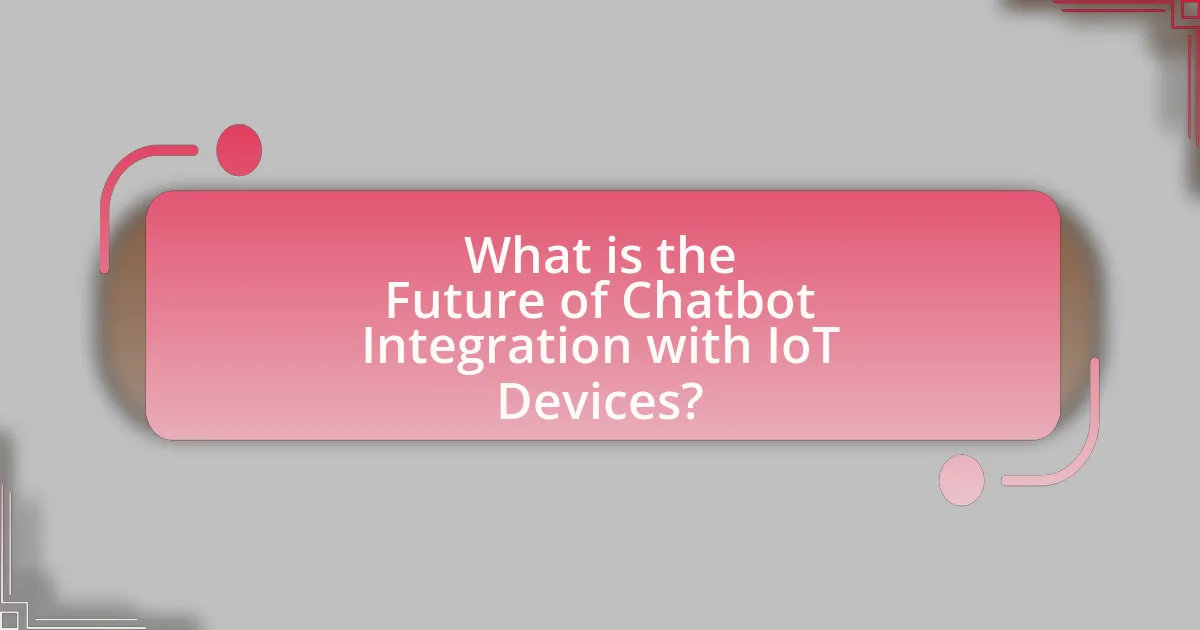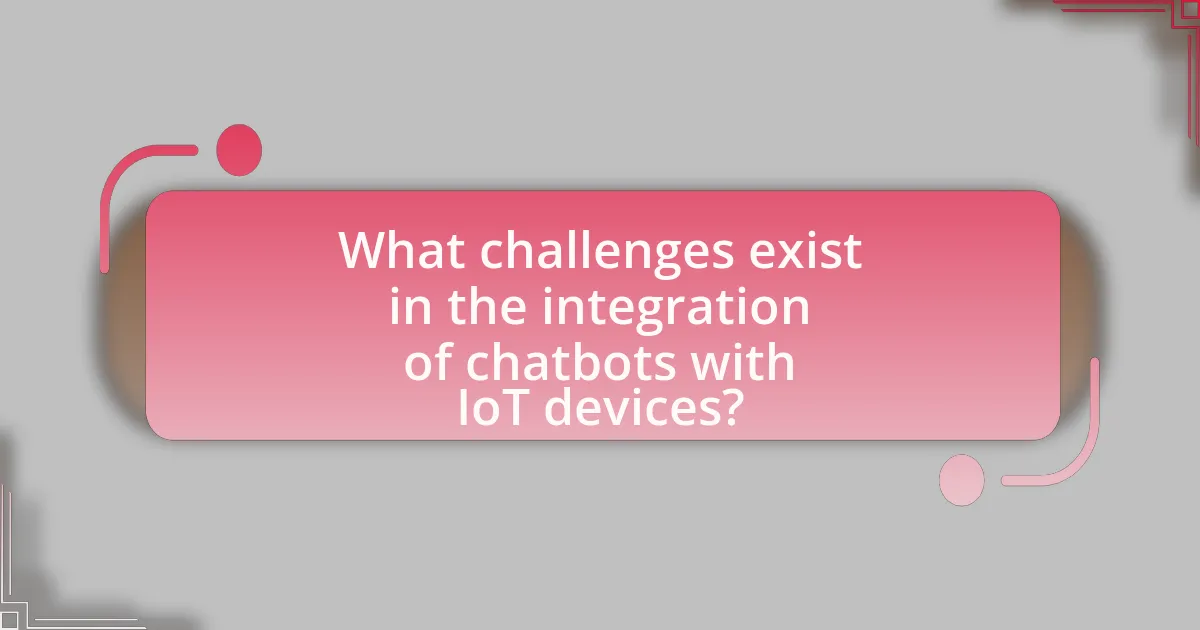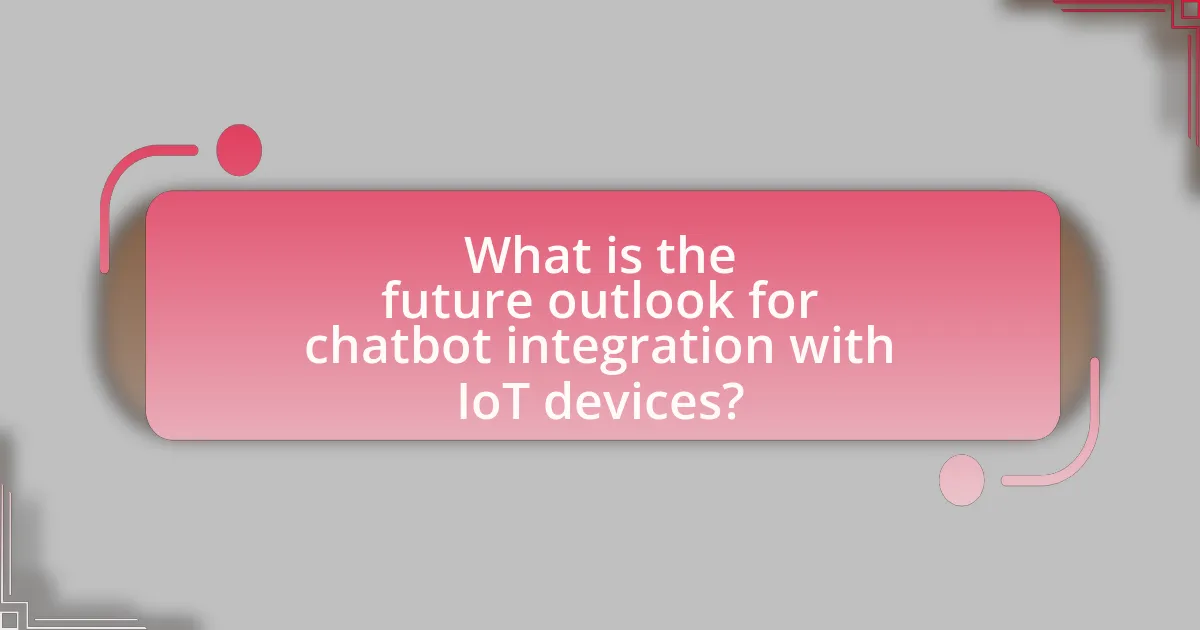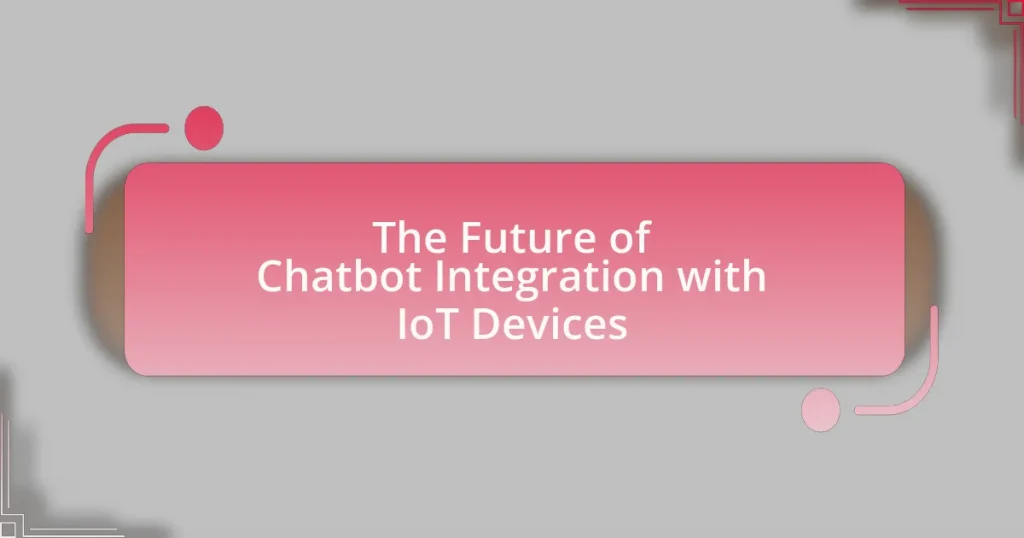The article focuses on the future of chatbot integration with Internet of Things (IoT) devices, highlighting the enhanced interactivity and automation that this integration promises. It discusses current applications of chatbots in managing IoT devices, the technologies enabling this integration, and the benefits such as improved user engagement and operational efficiency. Additionally, the article addresses challenges like interoperability and data privacy, while exploring strategies to enhance chatbot functionality and security. It concludes with insights on how advancements in artificial intelligence and emerging technologies will shape the future landscape of chatbot and IoT interactions.

What is the Future of Chatbot Integration with IoT Devices?
The future of chatbot integration with IoT devices is characterized by enhanced interactivity and automation, enabling seamless communication between users and smart devices. As IoT adoption increases, chatbots will leverage artificial intelligence to provide real-time data analysis, personalized user experiences, and proactive device management. For instance, a report by Gartner predicts that by 2025, 75% of customer service interactions will be powered by AI, including chatbots, which will facilitate smoother operations in smart homes and industrial settings. This integration will not only improve user engagement but also optimize device functionality, leading to more efficient energy use and maintenance.
How are chatbots currently integrated with IoT devices?
Chatbots are currently integrated with IoT devices by serving as user interfaces that facilitate communication and control over connected devices. This integration allows users to interact with smart home systems, wearables, and industrial IoT applications through natural language processing, enabling voice commands or text-based queries to manage device settings, retrieve information, and automate tasks. For instance, platforms like Amazon Alexa and Google Assistant enable users to control smart appliances, adjust lighting, and monitor security systems via conversational interactions, demonstrating the practical application of chatbots in enhancing user experience and operational efficiency in IoT ecosystems.
What technologies enable chatbot and IoT device integration?
Technologies that enable chatbot and IoT device integration include Application Programming Interfaces (APIs), cloud computing, and natural language processing (NLP). APIs facilitate communication between chatbots and IoT devices, allowing them to exchange data and commands seamlessly. Cloud computing provides the necessary infrastructure for data storage and processing, enabling real-time interactions. NLP allows chatbots to understand and respond to user queries effectively, enhancing user experience. These technologies collectively support the integration by ensuring efficient data flow and interaction between chatbots and IoT devices.
How do chatbots enhance user interaction with IoT devices?
Chatbots enhance user interaction with IoT devices by providing a conversational interface that simplifies control and management of these devices. This interaction allows users to issue commands, receive updates, and troubleshoot issues through natural language, making the technology more accessible. For instance, a study by Gartner indicates that by 2025, 75% of households will have at least one smart device, and chatbots will facilitate seamless communication between users and these devices, improving user experience and engagement.
What are the potential benefits of integrating chatbots with IoT devices?
Integrating chatbots with IoT devices enhances user interaction and automates processes, leading to increased efficiency and convenience. This integration allows users to control and monitor IoT devices through natural language, simplifying complex tasks. For instance, a study by Gartner indicates that by 2025, 75% of households will have at least one smart device, highlighting the growing reliance on IoT technology. Furthermore, chatbots can provide real-time data and insights from IoT devices, enabling proactive decision-making and improved user experiences. This synergy not only streamlines operations but also fosters a more intuitive interface for users, ultimately driving greater adoption of IoT solutions.
How can chatbots improve efficiency in IoT systems?
Chatbots can improve efficiency in IoT systems by providing real-time communication and automation of tasks. They facilitate user interaction with IoT devices, allowing for seamless control and monitoring through natural language processing. For instance, a study by Gartner indicates that by 2025, 75% of customer service interactions will be powered by AI, including chatbots, which can significantly reduce response times and operational costs. This integration enables users to manage multiple devices simultaneously, streamlining processes and enhancing user experience.
What role do chatbots play in enhancing user experience with IoT devices?
Chatbots significantly enhance user experience with IoT devices by providing intuitive, conversational interfaces that simplify device interaction. They enable users to control and monitor their IoT devices through natural language, reducing the complexity often associated with technology. For instance, a study by Gartner indicates that by 2025, 75% of households will have at least one smart device, and chatbots will facilitate seamless communication with these devices, allowing users to issue commands or receive updates effortlessly. This integration not only improves accessibility but also fosters user engagement, as chatbots can offer personalized recommendations based on user preferences and behaviors.

What challenges exist in the integration of chatbots with IoT devices?
The integration of chatbots with IoT devices faces several challenges, including interoperability, data privacy, and real-time processing. Interoperability issues arise because different IoT devices often use various communication protocols, making it difficult for chatbots to interact seamlessly across platforms. Data privacy concerns are significant, as chatbots may handle sensitive information from users, necessitating robust security measures to protect this data. Additionally, real-time processing is crucial for effective communication; however, the latency in data transmission between IoT devices and chatbots can hinder timely responses, impacting user experience. These challenges highlight the complexities involved in creating a cohesive and efficient integration of chatbots with IoT systems.
What are the technical hurdles in chatbot and IoT integration?
The technical hurdles in chatbot and IoT integration include interoperability, data security, and real-time processing. Interoperability challenges arise from the diverse protocols and standards used by various IoT devices, making it difficult for chatbots to communicate effectively across different platforms. Data security is a significant concern, as integrating chatbots with IoT devices can expose sensitive information to potential breaches, necessitating robust encryption and authentication measures. Real-time processing is crucial for effective interaction; however, the latency in data transmission between IoT devices and chatbots can hinder timely responses, impacting user experience. These challenges highlight the complexities involved in achieving seamless integration between chatbots and IoT systems.
How does data privacy impact chatbot integration with IoT devices?
Data privacy significantly impacts chatbot integration with IoT devices by necessitating stringent data protection measures to safeguard user information. As chatbots interact with IoT devices, they often collect and process sensitive data, such as personal preferences and usage patterns. This data must be handled in compliance with regulations like the General Data Protection Regulation (GDPR), which mandates transparency, user consent, and the right to data access and deletion. Failure to adhere to these privacy standards can lead to legal repercussions and loss of user trust, ultimately hindering the effectiveness and adoption of chatbot technologies in IoT ecosystems.
What are the limitations of current chatbot technologies in IoT applications?
Current chatbot technologies in IoT applications face several limitations, including limited contextual understanding, dependency on structured data, and challenges in handling multi-modal interactions. Limited contextual understanding restricts chatbots from accurately interpreting user intent and providing relevant responses, which is crucial in dynamic IoT environments. Dependency on structured data means that chatbots often struggle with unstructured or ambiguous inputs, leading to miscommunication. Additionally, challenges in handling multi-modal interactions, such as voice, text, and visual inputs, hinder the seamless integration of chatbots with diverse IoT devices, reducing their effectiveness in real-world applications. These limitations highlight the need for advancements in natural language processing and machine learning to enhance chatbot capabilities in IoT contexts.
How can these challenges be addressed?
To address the challenges of chatbot integration with IoT devices, implementing robust interoperability standards is essential. These standards facilitate seamless communication between diverse IoT devices and chatbots, ensuring compatibility and reducing integration complexities. For instance, the adoption of protocols like MQTT (Message Queuing Telemetry Transport) has proven effective in enhancing communication efficiency among IoT devices, as evidenced by its widespread use in smart home applications. Additionally, investing in advanced natural language processing (NLP) technologies can improve chatbots’ understanding of user intents, thereby enhancing user experience and engagement. Research indicates that NLP advancements can lead to a 30% increase in user satisfaction in IoT applications, demonstrating the tangible benefits of addressing these challenges through technology.
What strategies can be implemented to enhance chatbot functionality in IoT?
To enhance chatbot functionality in IoT, integrating natural language processing (NLP) capabilities is essential. This allows chatbots to understand and respond to user queries more effectively, improving user experience. Additionally, implementing machine learning algorithms enables chatbots to learn from interactions, thereby personalizing responses based on user behavior and preferences.
Furthermore, ensuring seamless connectivity between IoT devices and chatbots is crucial; this can be achieved through standardized communication protocols like MQTT or CoAP, which facilitate real-time data exchange. Incorporating context-awareness allows chatbots to provide relevant information based on the user’s current environment or device status, enhancing the interaction quality.
Lastly, utilizing analytics to monitor chatbot performance and user engagement can inform iterative improvements, ensuring that the chatbot evolves alongside user needs and technological advancements. These strategies collectively contribute to a more robust and effective chatbot functionality within IoT ecosystems.
How can developers ensure data security in chatbot-IoT interactions?
Developers can ensure data security in chatbot-IoT interactions by implementing end-to-end encryption for data transmission. This method protects sensitive information from being intercepted during communication between chatbots and IoT devices. Additionally, developers should utilize secure authentication protocols, such as OAuth 2.0, to verify user identities and restrict access to authorized users only. Regular security audits and vulnerability assessments can further identify and mitigate potential risks in the system. According to a report by the Internet of Things Security Foundation, 70% of IoT devices are vulnerable to attacks due to inadequate security measures, highlighting the necessity for robust security practices in chatbot-IoT integrations.

What is the future outlook for chatbot integration with IoT devices?
The future outlook for chatbot integration with IoT devices is highly promising, as advancements in artificial intelligence and machine learning continue to enhance the capabilities of both technologies. By 2025, it is projected that the global IoT market will reach $1.1 trillion, with chatbots playing a crucial role in facilitating user interactions with smart devices. This integration will enable seamless communication, allowing users to control and monitor their IoT devices through natural language processing. Furthermore, a report by Gartner indicates that by 2024, 75% of customer service interactions will be powered by AI, including chatbots, which will significantly improve user experience and operational efficiency in IoT ecosystems.
How will advancements in AI influence chatbot and IoT integration?
Advancements in AI will significantly enhance chatbot and IoT integration by enabling more sophisticated interactions and real-time data processing. As AI algorithms improve, chatbots will become more adept at understanding natural language, allowing them to interpret user queries related to IoT devices more accurately. For instance, AI-driven chatbots can analyze data from connected devices to provide personalized recommendations or troubleshoot issues, thereby improving user experience. Research indicates that the global AI in IoT market is expected to grow from $5.1 billion in 2020 to $16.2 billion by 2025, highlighting the increasing reliance on AI for effective IoT management. This growth underscores the potential for AI to transform how chatbots interact with IoT systems, making them more responsive and intelligent.
What emerging technologies could shape the future of this integration?
Emerging technologies that could shape the future of chatbot integration with IoT devices include artificial intelligence (AI), natural language processing (NLP), edge computing, and 5G connectivity. AI enhances chatbots’ ability to understand and respond to user queries more effectively, while NLP allows for more human-like interactions. Edge computing reduces latency by processing data closer to the source, which is crucial for real-time responses in IoT environments. Additionally, 5G connectivity provides the high-speed data transfer necessary for seamless communication between chatbots and IoT devices, enabling more complex interactions and functionalities. These technologies collectively enhance the efficiency and user experience of chatbot integration with IoT systems.
How might user expectations evolve regarding chatbot interactions with IoT devices?
User expectations regarding chatbot interactions with IoT devices are likely to evolve towards greater personalization and seamless integration. As IoT devices become more prevalent, users will expect chatbots to understand their preferences and context, enabling more tailored responses and proactive assistance. For instance, a study by Gartner predicts that by 2025, 75% of customer service interactions will be powered by AI, indicating a shift towards more intelligent and responsive systems. This evolution will require chatbots to leverage data from connected devices to enhance user experience, making interactions more intuitive and efficient.
What practical steps can businesses take to leverage chatbot integration with IoT?
Businesses can leverage chatbot integration with IoT by implementing a multi-step approach that includes defining clear use cases, selecting appropriate IoT devices, and utilizing robust APIs for seamless communication. First, businesses should identify specific scenarios where chatbots can enhance user interaction with IoT devices, such as smart home management or industrial automation. Next, selecting IoT devices that support chatbot functionality is crucial; for instance, devices with built-in voice recognition can facilitate direct communication. Finally, employing APIs that enable real-time data exchange between chatbots and IoT devices ensures effective responses and actions based on user queries. This structured approach allows businesses to optimize customer engagement and operational efficiency through integrated technologies.
What best practices should be followed for successful implementation?
Successful implementation of chatbot integration with IoT devices requires a clear strategy, robust infrastructure, and user-centric design. Establishing a well-defined use case is essential, as it guides the development process and ensures that the chatbot meets specific user needs. Additionally, leveraging APIs for seamless communication between the chatbot and IoT devices enhances functionality and user experience.
Regular testing and iteration are crucial; they allow for the identification of issues and the refinement of features based on user feedback. Furthermore, ensuring data security and privacy is paramount, as IoT devices often handle sensitive information. According to a report by Gartner, 75% of IoT projects fail due to lack of proper implementation strategies, highlighting the importance of following these best practices for success.
How can businesses measure the effectiveness of chatbot integration with IoT devices?
Businesses can measure the effectiveness of chatbot integration with IoT devices by analyzing key performance indicators (KPIs) such as user engagement rates, response accuracy, and task completion rates. User engagement rates can be tracked through metrics like the number of interactions per session and the frequency of user return visits, which indicate how well the chatbot meets user needs. Response accuracy can be evaluated by assessing the percentage of correct responses provided by the chatbot in relation to user queries, ensuring that the chatbot effectively understands and processes IoT-related requests. Task completion rates measure the proportion of users who successfully complete their intended actions through the chatbot, reflecting its efficiency in facilitating IoT device management. Additionally, businesses can utilize customer feedback and satisfaction surveys to gain qualitative insights into user experiences, further validating the chatbot’s effectiveness in enhancing IoT interactions.










